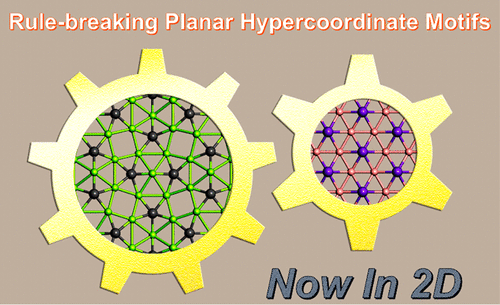当前位置:
X-MOL 学术
›
Acc. Chem. Res.
›
论文详情
Our official English website, www.x-mol.net, welcomes your
feedback! (Note: you will need to create a separate account there.)
Planar Hypercoordinate Motifs in Two-Dimensional Materials.
Accounts of Chemical Research ( IF 16.4 ) Pub Date : 2020-03-30 , DOI: 10.1021/acs.accounts.0c00025 Yu Wang 1 , Yafei Li 1 , Zhongfang Chen 2
Accounts of Chemical Research ( IF 16.4 ) Pub Date : 2020-03-30 , DOI: 10.1021/acs.accounts.0c00025 Yu Wang 1 , Yafei Li 1 , Zhongfang Chen 2
Affiliation

|
ConspectusAs one of the most important and versatile elements, carbon renders itself as one of the most fundamental and cutting-edge topics in chemistry, physics, and materials science. Many carbon-based chemical rules were established accordingly. While the tetrahedral predilection of tetracoordinate carbon has been a cornerstone of organic chemistry since 1874, almost a century later tetracoordinate carbon was found to be able to adopt planar structures known as planar tetracoordinate carbon (ptC), which are stabilized electronically by good π-acceptor (delocalization of a lone electron pair of ptC) or σ-donor (promoting electron transfer to electron-deficient bonding) substituents or mechanically by appropriate steric enforcement. The experimental and theoretical achievements for the rule-breaking ptC species totally refreshed our understanding of chemical bonding and triggered exploration of peculiar molecules featuring planar pentacoordinate carbon (ppC) and planar hexacoordinate carbon (phC) as well as other outlandish species such as planar hypercoordinate silicon.While the planar hypercoordinate carbon chemistry has been gradually established for molecules in the past five decades, there is growing interest in pursuing their extension systems, especially in two-dimensional (2D) space as a result of the recent extensive studies of graphene and its analogues. Though the natural 2D layered crystals do not contain any planar hypercoordinate carbon or silicon, several 2D nanosheets featuring planar or quasi-planar hypercoordinate ones have been theoretically suggested. Encouragingly, these unique planar configurations possess decent stabilities, and some of them are even the global minimum structure, exhibiting great potential for experimental realization. As the nature of a material is mainly determined by its structural characteristics (e.g., dimensionality, crystallography, and bonding), the combination of planar hypercoordinate chemistry and 2D nanoscience not only endows these rule-breaking systems with the merits of 2D materials but also may offer various promising properties and applications. For example, an unusual negative Poisson's ratio can be found in ppC-containing Be5C2 and planar pentacoordinate silicon (ppSi)-containing CaSi monolayers, of which the former has an anisotropic Dirac cone and the latter is a semiconductor with a desirable band gap for the semiconductor industry. Specially, shortly after the theoretical prediction, a planar hexacoordinate silicon (phSi)-containing Cu2Si monolayer was experimentally synthesized and characterized with the 2D Dirac nodal line fermion, which offers a platform to achieve high-speed, low-dissipation nanodevices.In this Account, we review the recent progress, mostly by density functional theory (DFT) computations, in designing 2D materials with planar hypercoordinate motifs. We describe the key achievements in this field, paying special attention to the "bottom-up" and "isoelectronic substitution" design strategies. In addition, the fundamental stabilization mechanisms of planar hypercoordinate motifs in an infinite layer are discussed. We hope that this Account will inspire more experimental and theoretical efforts to explore nanomaterials with such unconventional chemical bonding.
中文翻译:

二维材料中的平面超坐标图案。
概观作为最重要,用途最广泛的元素之一,碳使自己成为化学,物理学和材料科学中最基本,最前沿的主题之一。相应地建立了许多基于碳的化学规则。自1874年以来,四配位碳的四面体偏爱一直是有机化学的基础,但近一个世纪后,人们发现四配位碳能够采用称为平面四配位碳(ptC)的平面结构,该结构通过良好的π受体进行电子稳定。 (ptC的一个孤对电子离域)或σ供体(促进电子转移至电子缺陷键)取代基或通过适当的空间强制方式进行机械取代。突破性ptC物种的实验和理论成就完全刷新了我们对化学键的理解,并触发了对具有平面五配位碳(ppC)和平面六配位碳(phC)以及其他奇特物种如平面超配位硅的奇特分子的探索。尽管在过去的五十年中已经逐渐为分子建立了平面超配位碳化学,但是由于最近对石墨烯及其分子的广泛研究,人们对追求其扩展系统,尤其是在二维(2D)空间的兴趣日益浓厚。类似物。尽管天然的2D层状晶体不包含任何平面的超坐标碳或硅,但理论上已提出了一些具有平面或准平面超坐标的2D纳米片。令人鼓舞的是,这些独特的平面配置具有不错的稳定性,其中一些甚至是全局最小结构,具有巨大的实验实现潜力。由于材料的性质主要取决于其结构特征(例如,尺寸,晶体学和键合),因此平面超坐标化学和2D纳米科学的结合不仅赋予这些打破常规的系统2D材料的优点,而且还可能提供各种有前途的特性和应用。例如,在含ppC的Be5C2和平面五坐标含硅(ppSi)的CaSi单层中会发现不寻常的负泊松比,其中前者具有各向异性的狄拉克锥,后者是具有理想带隙的半导体。半导体产业。特别,在理论预测之后不久,就通过实验方法合成了含平面六坐标硅(phSi)的Cu2Si单层,并用2D Dirac节点线费米子进行了表征,这为实现高速,低耗散的纳米器件提供了一个平台。回顾了最近在设计具有平面超坐标图案的2D材料方面的最新进展,主要是通过密度泛函理论(DFT)计算。我们描述了该领域的主要成就,并特别注意了“自下而上”和“等电子替代”的设计策略。此外,讨论了无限层中平面超坐标图案的基本稳定机制。
更新日期:2020-04-23
中文翻译:

二维材料中的平面超坐标图案。
概观作为最重要,用途最广泛的元素之一,碳使自己成为化学,物理学和材料科学中最基本,最前沿的主题之一。相应地建立了许多基于碳的化学规则。自1874年以来,四配位碳的四面体偏爱一直是有机化学的基础,但近一个世纪后,人们发现四配位碳能够采用称为平面四配位碳(ptC)的平面结构,该结构通过良好的π受体进行电子稳定。 (ptC的一个孤对电子离域)或σ供体(促进电子转移至电子缺陷键)取代基或通过适当的空间强制方式进行机械取代。突破性ptC物种的实验和理论成就完全刷新了我们对化学键的理解,并触发了对具有平面五配位碳(ppC)和平面六配位碳(phC)以及其他奇特物种如平面超配位硅的奇特分子的探索。尽管在过去的五十年中已经逐渐为分子建立了平面超配位碳化学,但是由于最近对石墨烯及其分子的广泛研究,人们对追求其扩展系统,尤其是在二维(2D)空间的兴趣日益浓厚。类似物。尽管天然的2D层状晶体不包含任何平面的超坐标碳或硅,但理论上已提出了一些具有平面或准平面超坐标的2D纳米片。令人鼓舞的是,这些独特的平面配置具有不错的稳定性,其中一些甚至是全局最小结构,具有巨大的实验实现潜力。由于材料的性质主要取决于其结构特征(例如,尺寸,晶体学和键合),因此平面超坐标化学和2D纳米科学的结合不仅赋予这些打破常规的系统2D材料的优点,而且还可能提供各种有前途的特性和应用。例如,在含ppC的Be5C2和平面五坐标含硅(ppSi)的CaSi单层中会发现不寻常的负泊松比,其中前者具有各向异性的狄拉克锥,后者是具有理想带隙的半导体。半导体产业。特别,在理论预测之后不久,就通过实验方法合成了含平面六坐标硅(phSi)的Cu2Si单层,并用2D Dirac节点线费米子进行了表征,这为实现高速,低耗散的纳米器件提供了一个平台。回顾了最近在设计具有平面超坐标图案的2D材料方面的最新进展,主要是通过密度泛函理论(DFT)计算。我们描述了该领域的主要成就,并特别注意了“自下而上”和“等电子替代”的设计策略。此外,讨论了无限层中平面超坐标图案的基本稳定机制。











































 京公网安备 11010802027423号
京公网安备 11010802027423号